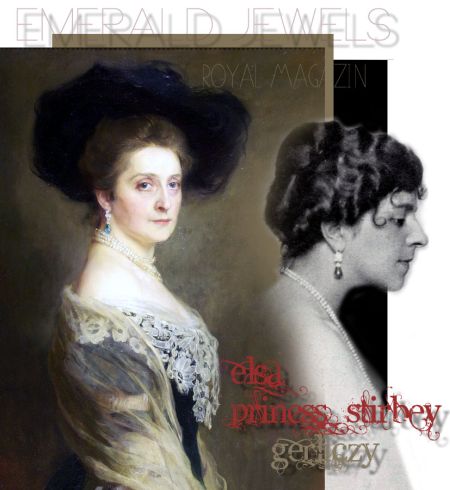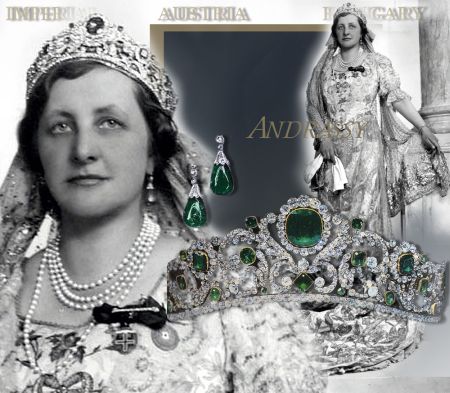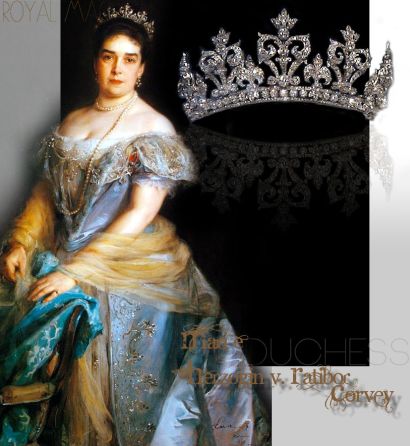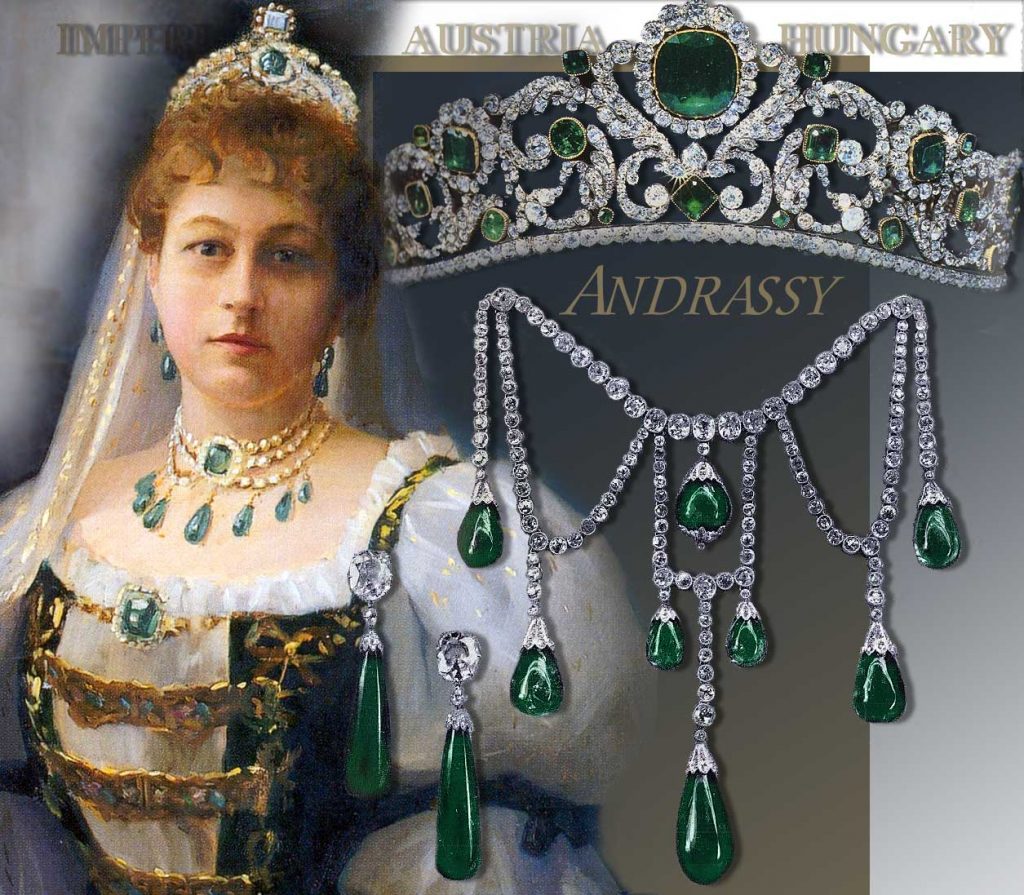French Crown Jewels France | Duchesse d’Angoulême Emerald Tiara
Diadème de la duchesse d’Angoulême | Diamants de la Couronne
Smaragd Diadem der Herzogin von Angoulême | Kronjuwelen von Frankreich
Das Smaragd und Diamant-Tiara ist ein Meisterwerk von Schmuck aus der Zeit der Restoration. Es bereichert die Sammlung der Kronjuwelen im Jahr 1887 und da verstreut geduldig von der Abteilung für dekorative Kunst des Louvre versammelt. Seiner Nichte die Herzogin von Angouleme Angeboten von Louis XVIII, ist es das Werk von Frédéric Bapst Kitts und Jacques Evrard Bapst, Juwelier, um die Krone bis zum zweiten Kaiserreichs.
Die Herzogin von Angouleme (1778-1851), Tochter von Louis XVI und Nichte Ludwigs XVIII erhielt den Schmuck seines Onkels. Sie hatte bereits eine Livree Smaragdhalsband von der Juwelier Paul-Nicolas Meniere von 1814. Dieses Set enthalten einen Kamm, eine Halskette, Armbänder und Ohrringe. Das Diadem, anstelle von Schmuck, von der Herzogin von Angouleme Besitz, ist mit der Bestandsaufnahme der Crown Diamanten registriert. Er verwendet vier große Smaragde in der Tat von Louis XVIII und Diamanten von Crown Sammlungen erworben. Unter dem Second Empire, wurde das Diadem der Kaiserin Eugenie, die besonders geschätzt die Smaragde getragen. Dann wurde es mit anderen Juwelen der Krone im Jahre 1887, bevor wieder auftaucht in einer Privatsammlung verkauft.
40 Smaragden und Diamanten in 1031
In der Mitte des Diadems, zwischen zwei Wicklungen während brilliant, ein großes Smaragd von 18 Diamanten umgeben ist. Diese 15,93 Karat Smaragd fast quadratisch und sehr dünn, begleitet von vierzehn Smaragde, darunter zwei auf jeder Seite angebracht. Diese beiden Seiten Smaragde 14.19 Karat messen 14,13 cm. Jewelers Bapst complétèrent dieses Set von 26 kleinen Smaragden bis 29 Karat. Insgesamt verfügt das Diadem besteht aus 40 Smaragden und Diamanten im Jahr 1031. Die zentrale smaragd durch 18 Diamanten umgeben ist. Die andere brillante Form mit Laub, die angebracht Kätzchen Unterstützung Smaragde sind. Alles auf einer Galerie, die aus einer Reihe von glänzend.
Qualität Juweliere
Das klassische Design dieses Diadem wurde von Jacques Evrard Bapst (1771-1842) durch die Steiffert Verfasserin unterstützt werden. Das Diadem ist das Werk des Hauses Bapst Kopf davon stand seit 1817-Christophe Bapst Frédéric (1789-1870), der Neffe des Jacques Evrard, der von seinem Vater-Paul-Nicolas Menière letzten genommen hatte Juwelier des alten Regimes. Der Bapst Halle kamen aus Schwaben und war in Paris für Louis XV siedelt. Jacques Evrard hat das Crown Juwelier Patent im Jahre 1821, ein Titel, den er bis zum Zweiten Reiches gehalten. Das Diadem, das Bapst realisiert für die Herzogin von Angouleme ist ein Meisterwerk von Schmuck Restaurierung durch den Reichtum der Steine, die Qualität ihrer Pferde und klassische Inspiration.
Rubin Parure der französischen Krone | The Imperial Ruby-Diamond-Parure
Modell der Rubin Parure aus dem 19.Jhdt | Replica of the Imperial Ruby-Diamond-Parure
Die Orginalversion der Smaragd Parure | The Imperial Emerald-Diamond-Parure
Die Kaiserin mit der Smaragd-Garnitur | The Empress wearing the Emerald-Parure
Spätere Versionen der Smaragd Tiara | Later Versions of the tiara
Das Smaragdcollier und die Ohrringe| The Emerald-Diamond-Necklace and the Earrings with Emeralds
Königliche und Kaiserliche Juwelen | Royal and Imperial Jewels of France
This emerald and diamond tiara is a masterpiece of jewelery of the Restoration. It enriches the collection of crown jewels scattered in 1887 and since patiently gathered by the Department of Decorative Arts of the Louvre. Offered by Louis XVIII to his niece the Duchess of Angouleme, it is the work of Frédéric Bapst Kitts and Jacques Evrard Bapst, jeweler to the Crown until the Second Empire.
A work made for a princess
Magnificent Diadem of Grace and Charm, Emeralds and Diamonds composed of nine graduating in size to a large centre, with continuing foliate scroll
The Duchess of Angouleme (1778-1851), daughter of Louis XVI and niece of Louis XVIII received the adornment of her uncle. She already had a livery emerald necklace by the jeweler Paul-Nicolas Meniere from 1814. This set included a comb, a necklace, bracelets and earrings. The diadem, instead of adornment, owned by the Duchess of Angouleme, is registered with the inventory of Crown Diamonds. It uses four large emeralds indeed purchased by Louis XVIII and diamonds from Crown collections. Under the Second Empire, the diadem was worn by the Empress Eugenie, who particularly appreciated the emeralds. Then it was sold with other jewels of the crown in 1887 before reappearing in a private collection.
40 emeralds and diamonds in 1031
In the center of the diadem, between two windings while brilliant, a large emerald surrounded by 18 diamonds. This 15.93 carat emerald almost square and very thin, accompanied by fourteen emeralds including two attached to either side. These two side emeralds 14.19 carats measure 14.13 cm. Jewelers Bapst complétèrent this set by 26 small emeralds to 29 carats. In total the diadem consists of 40 emeralds and diamonds in 1031. The central emerald is surrounded by 18 diamonds. The other brilliant form with foliage which are attached kittens supporting emeralds. All on a gallery consisting of a row of shiny.
Quality jewelers
The classic design of this tiara was made by Jacques Evrard Bapst (1771-1842) supported by the Steiffert draftsman. The tiara is the work of the house Bapst head of which stood since 1817-Christophe Bapst Frédéric (1789-1870), nephew of Jacques Evrard, who had taken over from his father-Paul-Nicolas Menière last jeweler of the old regime. The Bapst Hall came from Swabia and had settled in Paris for Louis XV. Jacques Evrard won the Crown jeweler patent in 1821, a title he kept until the Second Empire. The diadem that Bapst realized for the Duchess of Angouleme is a masterpiece of jewelry
Une œuvre destinée à une princesse
La duchesse d’Angoulême (1778-1851), fille de Louis XVI et nièce de Louis XVIII reçut cette parure de son oncle. Elle possédait déjà une parure d’émeraudes livrée par le joaillier Paul-Nicolas Ménière dès 1814. Cette parure comprenait un peigne, un collier, des bracelets et des boucles d’oreilles. Le diadème, au contraire de la parure, propriété de la duchesse d’Angoulême, est inscrit sur l’inventaire des Diamants de la Couronne. Il utilise en effet quatre grosses émeraudes achetées par Louis XVIII et des diamants provenant des collections de la Couronne. Sous le Second Empire, le diadème fut porté par l’Impératrice Eugénie qui appréciait particulièrement les émeraudes. Puis il fut vendu avec les autres bijoux de la Couronne en 1887 avant de réapparaître dans une collection privée.
40 émeraudes et 1031 diamants
Au centre du diadème, entre deux enroulements tout en brillants, une grosse émeraude est entourée de 18 brillants. Cette émeraude de 15,93 carats presque carrée et très mince, est accompagnée de quatorze autres émeraudes dont deux fixées de part et d’autre. Ces deux émeraudes latérales de 14,19 carats mesurent 14,13 cm. Les joailliers Bapst complétèrent cet ensemble par 26 petites émeraudes pour 29 carats. Au total le diadème est composé de 40 émeraudes et 1031 diamants. L’émeraude centrale est entourée de 18 brillants. Les autres brillants forment des rinceaux de feuillage sur lesquels sont fixés les chatons soutenant les émeraudes. Le tout sur une galerie formée d’un rang de brillants.
Des joailliers de qualité
Le dessin très classique de ce diadème a été réalisé par Jacques-Evrard Bapst (1771-1842) secondé par le dessinateur Steiffert. Le diadème est l’œuvre de la maison Bapst à la tête de laquelle se trouvait depuis 1817 Christophe-Frédéric Bapst (1789-1870) neveu de Jacques-Evrard, qui avait pris la succession de son beau-père Paul-Nicolas Menière, dernier joaillier de l’Ancien Régime. Les Bapst étaient originaires de Hall en Souabe et étaient installés à Paris depuis Louis XV. Jacques-Evrard obtint le brevet de joaillier de la Couronne en 1821, titre qu’il conserva jusque sous le Second Empire. Le diadème que les Bapst ont réalisé pour la duchesse d’Angoulême est un chef d’œuvre de la joaillerie de la Restauration par la richesse des pierres, la qualité de leur monture et l’inspiration classique.









